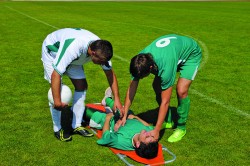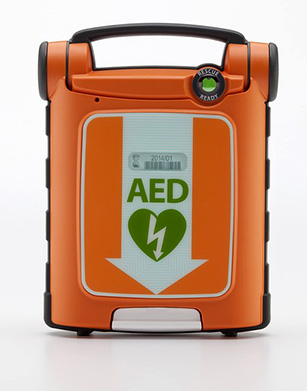SportsMed: Helping to avoid catastrophic injuries
Injuries are extremely common in high school and collegiate athletics, but the vast majority are not catastrophic. Because catastrophic injuries are rare, complacency about ensuring athlete safety can develop.
 Is your athletic department doing everything possible to prevent sudden death in sport? Has the possibility been considered for every venue where your teams practice or compete?
Is your athletic department doing everything possible to prevent sudden death in sport? Has the possibility been considered for every venue where your teams practice or compete?
- Cardiac conditions
- Exertional sickling (related to sickle cell anemia),
- Head injury
- Exertional heat stroke
- Asthma
In 2008, there were 14 high school and two youth-athlete deaths during sport participation. Some of these fatalities might have been prevented. For example, death from exertional heat stroke or exertional sickling is preventable. Athletic administrators must not forget that a primary responsibility is to ensure safe participation for all athletes.
Assessing heat stroke
Here’s a hypothetical scenario that could take place at any high school: After a couple of hours of intense soccer practice on a hot and humid day in August, a male player comes off the field complaining of dizziness, nausea and demonstrates confusion. The athletic trainer is on the football field, which is about a half-mile from the soccer field.
What should a coach do at this point? Is the athlete faking? Should the coach simply tell the athlete to take a drink of water and get back on the field? Does the coach realize that the athlete is presenting potential signs of exertional heat stroke?
The soccer player sits for a while on the sideline and drinks some water. He indicates that he wants to finish practice and complete the team conditioning at the end of practice. The coach agrees to allow participation in conditioning. In the middle of the conditioning session, the athlete collapses and becomes unresponsive.
Now what? How do your coaches contact the athletic trainer? How do your coaches determine whether this is a heat illness, sickling event or cardiac abnormality? Can they act in a calm  and confident manner to summon the appropriate care as soon as possible?
and confident manner to summon the appropriate care as soon as possible?
If there is hesitation in answering these questions, the potential for disaster exists. In this scenario, the athlete may have a core temperature above 106 degrees. This athlete may be in atrial fibrillation, which requires an automated external defibrillator (AED).
Coaches need to practice such scenarios to be confident in their responses. An athletic trainer is specifically trained to recognize warning signs and to act immediately to manage life-threatening situations. Proper management for a cardiac event involves AED utilization, cardiopulmonary resuscitation (CPR) and immediate transport. Management for exertional heat stroke requires immediate cooling, followed by transport.
Concussion, neck injury — or what?
Another potential life-threatening scenario involves a volleyball athlete jumping for a kill shot during a practice session. She gets struck on the side of her head by one of her teammates as she lands. She reports blurred vision, dizziness and headache. Should this athlete return to practice? Who should make the decision? What are the possible consequences if she is hit again?
If this athlete returns to practice and hits her head again, a fatal second impact syndrome is possible. This athlete needs to be examined immediately by an athletic trainer, emergency medical personnel or physician. The potential for sudden death in this scenario is minimized by restricting further participation. Simply restricting the athlete from returning to practice and referring her to the athletic trainer or team physician completes the appropriate steps.
Emergency action plan
To minimize the risk for sudden death, develop and practice an emergency action plan. Instruct all coaches about what to do in emergency situations. Coaches should be certified in first aid, CPR and AED use. These certifications are attained through organizations such as the American Red Cross and the American Heart Association and the skills learned could help keep a person alive until emergency medical personnel arrive.
Schools also should have the appropriate emergency equipment readily available. It does no good for coaches to be trained in AED use if there’s not one available.
Too often, a high school may have a single AED that is stored in a locked office. The AED must be accessible within one minute from the athletic practice or competition site. Survival rate decreases by 10 percent for every minute that AED application is delayed. Other emergency equipment includes the following: CPR masks, immobilization splints, personally prescribed epinephrine auto-injector pens and emergency inhalers.
Create emergency action plans to specify what should be done in the case of a potential emergency. Be sure that each practice and competition site has its own plan, which includes emergency phone numbers, directions to the site and entrances for emergency medical personnel access.
Have coaches maintain athlete health information with the emergency action plan, so that they can tell emergency medical personnel if the athlete has a medical condition or allergy, and to facilitate contact with a parent or guardian.
Once an emergency action plan has been developed, you should arrange a visit with a representative of the local emergency medical service agency to review its content. If appropriate plans are implemented, a sudden death might be prevented.
Fatalities are a rare, devastating result of athletic participation. It’s up to you to have a plan in place to limit the risk and potentially save an athletes life.





